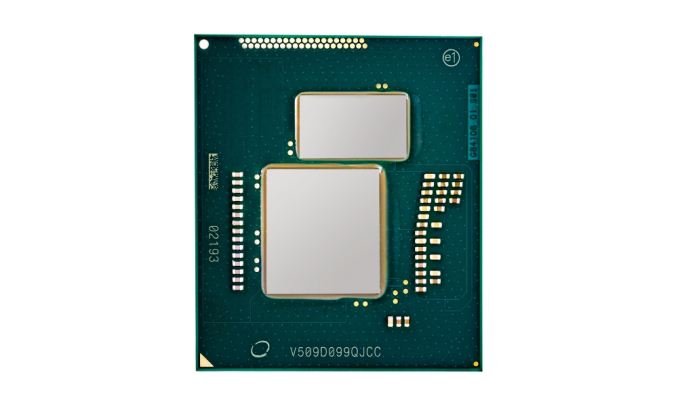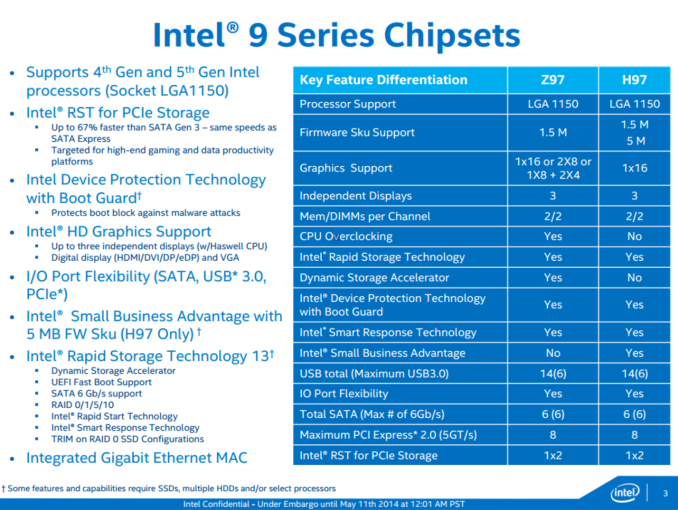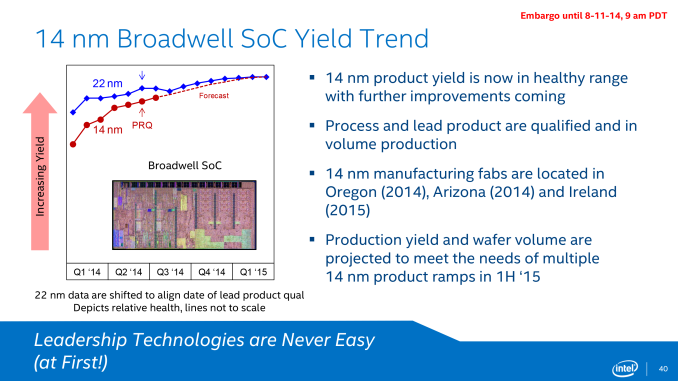The Intel Broadwell Desktop Review: Core i7-5775C and Core i5-5675C Tested (Part 1)
by Ian Cutress on June 2, 2015 7:45 AM ESTThe SKUs
While today's release doesn't preclude Intel from releasing additional Broadwell-DT processors in the future, for now here is what the starting lineup of five 65W SKUs looks like.
| Intel 65W Broadwell-DT Lineup | |||||
| i7-5775C | i7-5775R | i5-5675C | i5-5675R | i5-5575R | |
| Price | $366 | $348 | $276 | $265 | $244 |
| Cores | 4 | 4 | 4 | 4 | 4 |
| Threads | 8 | 8 | 4 | 4 | 4 |
| Base CPU Freq. | 3.3GHz | 3.3GHz | 3.1GHZ | 3.1GHZ | 2.8GHZ |
| Turbo CPU Freq. | 3.7GHz | 3.8GHz | 3.6GHz | 3.6GHz | 3.3GHz |
| Graphics | Iris Pro 6200 (GT3e) | Iris Pro 6200 (GT3e) | Iris Pro 6200 (GT3e) | Iris Pro 6200 (GT3e) | Iris Pro 6200 (GT3e) |
| EUs | 48 | 48 | 48 | 48 | 48 |
| iGPU Freq. | 1150MHz | 1150MHz | 1100MHz | 1100MHz | 1050MHz |
| TDP | 65W | 65W | 65W | 65W | 65W |
| DRAM Freq. (DDR3L) |
1600MHz | 1600MHz | 1600MHz | 1600MHz | 1600MHz |
| L3 Cache | 6MB | 6MB | 4MB | 4MB | 4MB |
| L4 Cache | 128MB (Crystal Well) | 128MB (Crystal Well) | 128MB (Crystal Well) | 128MB (Crystal Well) | 128MB (Crystal Well) |
| Interface | LGA | BGA | LGA | BGA | BGA |
Those with R at the end will be soldered down BGA parts, similar to the mobile Haswell-H models featuring Crystal Well. The two ‘C’ models will be socketed LGA parts, meaning that with a BIOS upgrade should be compatible in all Z87 and Z97 motherboards.
As for pricing, Intel's prices are fairly consistent with what they have been charging over the Haswell generation. The top-tier i7-5775C will fetch $366, a bit over the list price of the i7-4790K, but only about $10 off of the list price of the top Haswell Crystal Well part, i7-4770R. Otherwise the soldered counterpart to the i7 family, the i7-5775R, will go for a bit less at $348.
Below that we have the i5 family. The socketed i5-5675C will go for $276, which happens to be the same list price as the Crystal Well equipped i5-4670R, or $34 more than i5-4670K. Below that we have the last two soldered parts, the $265 i5-5675R, and the $244 i5-5575R.
Ultiamtely it goes without saying that none of these processors will be especially cheap, however with 128MB of eDRAM on-board we weren't necessarily expecting them to be, either. However what this also means is that Intel might take the iGPU crown from AMD, but it will come at nearly 3x the cost.
Broadwell-K, or is it Broadwell-C, or Broadwell-H?
In recent generations, Intel’s overclocking processors have all been given the K designation except the Pentium G3258 which is a special edition model celebrating Pentium’s 20th birthday (but affectionately called Pentium-K). Naturally then we assumed that even though we knew there would be Broadwell processors with Crystal Well, that any overclockable SKUs would be given the K name. But this is not the case, and as a result we have to deal with another identifier in Intel’s product stack. Thankfully, C for Crystal Well is somewhat obvious, although it avoids the overclocking element.
Intel’s other Crystal Well parts, those on Haswell that are for laptops and the three others in todays launch, are all called R. We’re still not sure why they are called R, but now we have Crystal Well with R and C. Something tells me that it might have been easier to call the socketed ones i7-RK, but would you believe it Intel is already using RK for its Atom x3 chip agreement with Rockchip. That leaves i7-CK as a potential, although many users will still call them Broadwell-K, just for ease of use. Intel internally wants to differentiate the K product line from the Crystal Well products, although adding overclocking to the new socketed processors confuses that mix.
Chipset Compatibility
The Broadwell processors will use the LGA1150 socket, which is currently found on all 8-series and 9-series chipsets. Based on our own internal testing, users should wait until a BIOS for their motherboard is available that officially supports the new processors. In our testing, putting in the CPU without the BIOS caused random freezing and the integrated graphics to fail on simple things such as navigating Chrome. It is also worth mentioning that early BIOSes might not allow overclocking, and this is primarily the reason why we are saving overclocking for another review.
On that note, motherboard manufacturers will typically put out a press release when a new CPU arrives to announce support on at least their major motherboards. Normally this press release appears before the official launch. That being said, similar to the Devil’s Canyon launch, we expect CPUs to be available towards the end of the month at the earliest, rather than on the shelves today.
The Reality
When I read about some of Intel’s plans with Broadwell-DT, I was confused. We are so used to having two sets of processors launched per socket with Intel, covering the complete range from Celerons at the bottom up to i7-K models at the top. Not having a wide range of processors this time will raise question marks, especially for those that want to upgrade to a Broadwell CPU. But I have sat for a while and racked my brains. This is what I have come with.
We all recognize that Intel’s 14nm process was late in getting acceptable yields and is also quite expensive in its own right. To that end, Intel started with the small dies before it moved up to the bigger quad-core ones for desktop and mobile, which given the prevelence of quad-cores in desktop SKUs (virtually the entire i5 and i7 ranges) delayed the desktop release even further. There has been much speculation as to when Skylake will come to market, as if I recall correctly Intel wants to keep to Moore’s Law as much as possible, and that means releasing Skylake at some point in 2015.
To that end, Broadwell-DT is a stop-gap to Skylake. In a stop-gap, you do not release a whole stack, because you end up annoying those who invest and then realise the next thing is just about to be released. So you have to release something interesting that will get interest or target a non-regular crowd. That crowd, by virtue of my comments earlier up the page, is those interested in integrated graphics and Crystal Well. Stick in some eDRAM, make it overclockable, and if you can take the integrated graphics crown from AMD, even better. Users who want peak integrated performance will invest, those wanting peak anything else will buy the greatest which might afford more profit or at least keep the investors happy. It also means that there will not be a massive amount of stock in the channel, so once the stop-gap's replacement is here, the stop-gap can quickly be shifted to End-Of-Life (EOL).
Did that make sense? The comment about EOL is an interesting one, as I have heard rumors from other technology media that they are expecting Broadwell-DT to be put into EOL relatively quickly. However, we can’t confirm this.
The Purpose of This Review
We were able to source both the i7-5775C and the i5-5675C to test, along with a reasonably updated BIOS but right around the time Computex was about to start. A combination of time and firmware means that this review will focus on stock performance, comparing it to other processors in its price range. We also had initial issues with testing the graphics, and due to time constraints again we only have IGP results for the i5, but also we only have Linux tests for the i7. But aside from that we were able to test both CPUs in our regular testing suite and have almost 200 data points between the two for comparison. One of my personal focal points was to retest the Crystal Well implementation for CPU performance, but this time we also get to test it with discrete graphics cards as well.













196 Comments
View All Comments
Taneli - Tuesday, June 2, 2015 - link
So how does it compare to 4770R?IUU - Tuesday, June 2, 2015 - link
Good , very good . Now after they have succeeded in this exercise, that is , showing they can build decent igpu, they can finally proceed to the real goal. Make a little bit weaker processors with the same igpu for real laptops, where portability but performance as well are needed at the same time.Then, throw away the burden of the i-gpu part for real desktop parts and complete the desktop series with 80 100 and 130 watts models.
Trying to persuade customers that from now on this is the high end is not going to work. The desktop
or desktop like derivatives should be at the front end of new computer challenges, none of which is
what we describe today as consumer needs(with the exception of gaming of course which admit it or not will always be one of the most demanding software).
Consider that pattern recognition(be it sound video or logic-language) will demand a lot of and parallel processing. Trying to push it as a network based service will not succeed at least as it is
envisioned right now. A significant part of it should be done locally. Now take this advice and conquer or abandon it and fail lol...
bill.rookard - Tuesday, June 2, 2015 - link
I'm not sure that they've proven they can build a decent iGPU. The whole point of integrated graphics is to provide an affordable solution with 'good enough' performance. While they have certainly hit the 'good enough' performance from both a CPU and GPU point of view, they've entirely missed the 'affordable' part of things. For the price of a single Intel CPU, you can almost get an AMD -system- which (while about 10% slower on average) is no small matter.Truth is (as pointed out) you can get an AMD chip with a $100 discrete graphics card which would blow either of the iGPUs away.
mrdude - Tuesday, June 2, 2015 - link
That's the issue both AMD and Intel have had with respect to their iGPUs. Once you've dedicated enough of the die to GPU transistors and skirted around the memory bottleneck (at least for Intel), you end up with a product that, while offering decent GPU performance, is horrendously overpriced for what it offers. Outside of niche scenarios, these things just don't make much sense given just how performance even cheap discrete GPUs can offer.I'd like to see what Intel's margins are on these parts and how much the eDRAM adds to the overall cost of the product. If yields are good and prices aren't much higher, I'd love to see Intel 'bite the bullet' in order to replace the entire product portfolio top-to-bottom. They'd benefit massively from it with respect to market share and being taken seriously with their gaming endeavor.
Unfortunately, I don't think Intel is willing to eat lower margins and a dip in profits for a long term gain, even if it would see a bucking of the current dip in sales with uptick in systems sold.
Refuge - Tuesday, June 2, 2015 - link
They have the best margins in the business.But of course they wont. Why lower prices, make less money now, kill AMD more, and then make more money later possibly if you don't lose out on some BS legal battle over having no compitition. Because it will happen, you know it will.
When instead you can continue to enjoy your large margins with minimal griping because the blame is being split between Intel's greed and AMD's inability to compete. Watch them die slowly, make more money while doing it. They control this playing field, why rock the boat when it is more profitable than it should be already?
Kjella - Tuesday, June 2, 2015 - link
And an Intel chip too, I wonder who are these people who'll pay $276-366 for something that'll get totally trashed by a $64 G3260 + $2-300 discrete graphics card. I guess the target market is AIOs that value style and low power consumption over performance and cost. If you look at their laptop prices, they're the same. So I'm guessing Intel didn't want manufacturers underclocking the 65W chips and using them as cheap 47W laptop chips. And the AIO makers wouldn't like Intel releasing a socketed chip cheaper than the identical BGA chip so the price is set with no grounding to reality in the desktop market.vision33r - Tuesday, June 2, 2015 - link
Majority of people can use G3260 + a decent vid card and have no clue it's a cheap underclass cpu. i5 and i7 are just marketing ploy for clueless people to buy the top level even though they don't know where the performance bottlenecks really are.Notmyusualid - Thursday, June 4, 2015 - link
You know, two of my brothers have i5 CPUs, and my i7 utterly trounces them, in every way. I was expecting the difference to be small, but oh no, for example, one brothers' 3230M does wPrime in < 19s, my i7 < 8s.This speed difference is reflected in the way the PCs 'feels' in every way. I'd say i7's are worth the money, despite seeing some i5s offer up great benchmarks online...
If gaming, then yes, you need an actual decent gpu, but for everything else, CPU counts most...
xulmar - Saturday, June 6, 2015 - link
Are you joking? 3230M? Obviously in laptops the story is different. In desktop the i5 and i7 are comparable, as the i7's main advantage is only the HT, but they still got 4 physical cores all the same. Laptop i5s are crippled processors. If intel would offer an i5 with 4 phsyical cores at a reasonable price - i'd buy it instantly. But 2+2 cores vs 4+4 in laptop i7 is hella difference. Obviously the processor can only be half as fast in multithreaded, if its only HALF of the i7... If you care even a bit about performance in a laptop, i7 is a no brainer, and sadly Intel is pushing the prices up, and replacing the middle class with the U processors which will sadly ruin everyone's dreams about reasonably priced PC performance in the future. This leaves an opportunity for AMD, as soon a quad i7 will be unavailable in any laptop under 1000 dollars...Namisecond - Wednesday, June 3, 2015 - link
"I wonder who are these people who'll pay $276-366 for something that'll get totally trashed by a $64 G3260 + $2-300 discrete graphics card."The same people who don't treat gaming benchmarks as the sole reason for their purchase. Once you get out of gamer culture, you'll find people value (whether mistakenly or not) CPU power over GPU power. In the corporate IT world, installing that $100 discrete GPU card can cost more than the hardware alone.